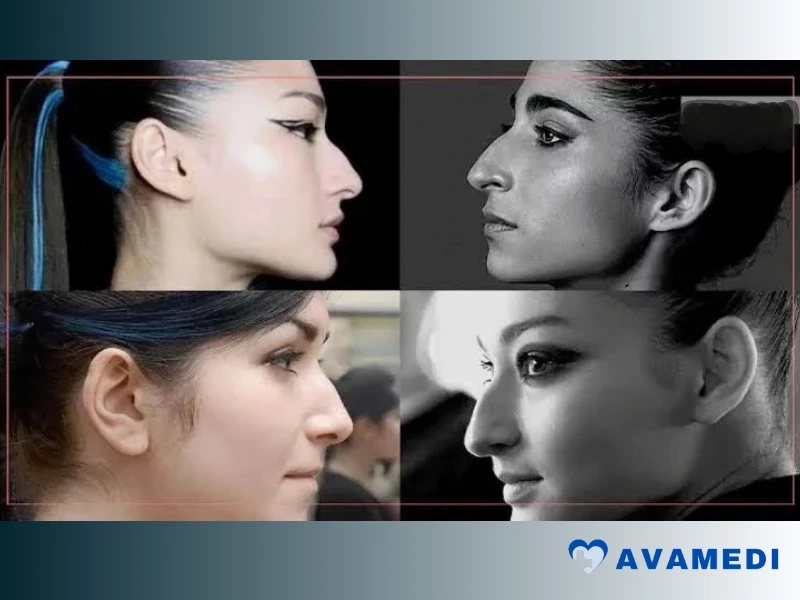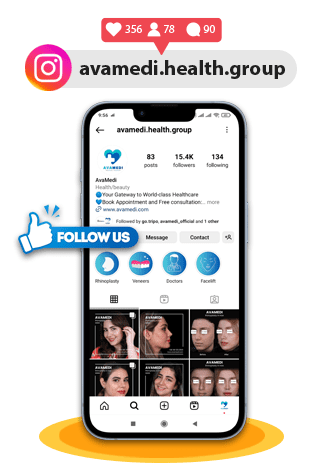An Aquiline Nose, often called a Roman nose, has sparked curiosity for centuries due to its distinctive shape and cultural associations. It`s one of the most famous types of noses. This type of nose has been viewed as a marker of strength, nobility, and even beauty in various cultures throughout history.
In this article, we’ll delve into what an aquiline nose is, its connection to ethnicity, the possibility of reshaping it through rhinoplasty, and how it compares to other nose shapes like the Greek and Roman noses. We’ll also examine its specific shapes and how it appears in women.
What is Aquiline Nose?
An aquiline nose is characterized by a prominent bridge that gives the nose a slightly curved, hooked appearance. The term “aquiline” comes from the Latin word aquilinus, which means “eagle-like,” referencing the curved beak of an eagle. This robust and angular shape typically slopes downward and can vary in degree from mildly noticeable to more pronounced curves.
People with an aquiline nose may be easily recognized because of this distinct shape. The curvature of the nose bridge often gives an elegant or sometimes authoritative look, which has led to this feature being associated with leadership and determination throughout history.
Art and literature depict the aquiline nose as a characteristic of powerful figures, including Roman emperors, military leaders, and royalty. The profile is often seen in sculptures of ancient civilizations, particularly in Roman and Greek art, where it is portrayed as a symbol of wisdom, nobility, and courage.
Aquiline Nose Ethnicity
The type of nose is not confined to a single ethnicity. It can be found across various ethnic groups and geographical regions. Historically, it has been more commonly associated with people of Mediterranean, Middle Eastern, and Central European descent.
- Mediterranean populations: Countries like Italy, Greece, and Turkey are known to have a higher prevalence of people with this type of nose. In these regions, the aquiline nose has been historically seen as a mark of strength and beauty.
- Middle Eastern populations: The aquiline nose is quite common in Middle Eastern cultures, especially among those from Iran, Lebanon, and Syria. This nose shape is sometimes perceived as a sign of intelligence and authority in this region, similar to the Perian Nose, which is a sign of authority and culture of the Iranian people.
- Central and Eastern Europeans: Aquiline noses are also quite common among certain European populations, including those in countries like Hungary and Poland.
- Native Americans: Interestingly, certain Native American tribes are said to exhibit aquiline nose shapes in their genetic makeup. This type of nose is also celebrated in indigenous art and cultural depictions.
Click (What are Middle Eastern nose features?) to read the article.
It’s important to note that while the aquiline nose is associated with these ethnic groups, it can appear in individuals of any race. Its presence is a matter of genetic diversity, and its perception varies by culture.

Aquiline Nose Rhinoplasty
For some, the unique shape of the aquiline nose may be a source of pride, while for others, it may be something they wish to alter. Rhinoplasty, commonly known as a “nose job,” is one of the most frequently performed cosmetic surgeries to change the shape of the nose, including the aquiline nose.
- Reasons for Rhinoplasty: Some people seek rhinoplasty for functional reasons, such as correcting breathing problems related to the nasal structure. Others may choose this surgery purely for aesthetic reasons, wanting to soften the curve of their nose or make it less prominent.
- Surgical Approach: Aquiline nose rhinoplasty typically involves reshaping the nose bridge, often by reducing or straightening the prominent curve. The surgeon may remove or adjust cartilage and bone to create a smoother, more balanced profile.
- Non-Surgical Options: For those who prefer less invasive methods, non-surgical rhinoplasty using dermal fillers can offer a temporary solution to modify the appearance of the aquiline nose. Fillers can be injected into areas around the nose to smooth out curves or subtly change its shape.
- Recovery and Results: Rhinoplasty recovery varies by individual, but swelling and bruising typically last several weeks. Full results can take several months to manifest as the nose continues to settle and heal. For many, the goal is not to completely change their nose but to enhance its natural features while achieving facial harmony.
Aquiline Nose vs Greek Nose
The aquiline nose and the Greek nose are often compared due to their prominence in ancient art and sculpture, but they are distinct in shape.
- Greek Nose: Also known as the “straight nose,” a Greek nose is characterized by its straight, even bridge with no curve or hump. It is named after the ancient Greeks, whose sculptures frequently featured individuals with this nose shape. This type of nose is considered classical and idealized in many cultures due to its symmetrical and balanced appearance.
- Aquiline Nose: In contrast, this nose type has a prominent, curved bridge, making it appear more angular and pronounced. This nose shape may give off a more intense or regal appearance than the softer profile of the Greek nose.
From an aesthetic perspective, the Greek nose is often associated with harmony and beauty, while the aquiline nose conveys strength and authority. Both noses have been admired in art and culture, but the Greek nose’s straightness has often been favored in Western beauty ideals.

Aquiline Nose vs Roman Nose
The terms “aquiline nose” and “Roman nose” are often used interchangeably, as they both describe a nose with a curved or slightly hooked bridge. However, there are subtle differences worth noting.
- Roman Nose: The Roman nose is named after the characteristic nose shape seen in the busts and statues of Roman emperors. It features a strong, high bridge that can be slightly curved, but not as pronounced as the classic aquiline shape.
- Aquiline Nose: This nose type, while similar, tends to have a sharper, more defined curve in the middle of the nose, giving it a more eagle-like appearance.
The Roman and aquiline noses are associated with power and authority, likely due to their prominence in historical figures and artworks from ancient Rome. However, this nose may appear more dramatic, while the Roman nose is slightly more subdued.
Also read: Big Nose Tip Surgery
Aquiline Nose Shape
The defining feature of the aquiline nose is the curvature of the nasal bridge, but the shape can vary significantly from person to person. The curve is subtle in some cases, while in others, it is more pronounced. Let’s explore a few variations:
- Classic Aquiline Nose: This is the most recognizable form, where the bridge of the nose slopes downward in a soft, continuous curve. It may give the face a more angular or elongated look.
- Aquiline Droopy Nose: In some cases, this nose shape can also result in a droopy appearance at the tip, where the end of the nose points downward. This can sometimes give the impression of a longer nose and may be seen as less aesthetically desirable by some. A droopy tip can be corrected through rhinoplasty if desired.
- Subtle Aquiline Nose: For others, the aquiline shape is much less dramatic, with a slight curve that gives the nose a gentle slope without appearing overly hooked or pointed.
Regardless of the specific variation, this type of nose can lend a face character and distinctiveness, often creating a striking, memorable, and unique profile.
Aquiline Droopy Nose
An aquiline droopy nose is a variation of the aquiline shape in which the tip points downward. This gives the nose a “droopy” appearance, especially from the side. The droopy tip can accentuate the curvature of the aquiline bridge, making the nose appear longer or more pronounced.
Many people with a droopy nose may opt for rhinoplasty to lift the nasal tip. This procedure can create a more upward-facing, refined nose tip, balancing the overall profile.
Non-surgical options, including dermal fillers, can also address the droopiness and temporarily adjust the tip’s position. However, rhinoplasty remains the most common choice for those seeking a permanent solution.
Avamedi offers multiple other services, such as Rhinoplasty in Iran.
Aquiline Nose Woman
Historically, the aquiline nose has often been seen as a masculine feature due to its strong and angular shape. However, many women proudly embrace their aquiline noses, and in some cultures, it is considered a sign of beauty, elegance, and strength in women.
- Cultural Perceptions: In Western beauty standards, women have traditionally favored softer, smaller noses, leading some women with aquiline noses to feel self-conscious. However, this perception has shifted, with more women celebrating their distinctive features, including aquiline noses.
- Famous Women: Numerous well-known women, such as Barbra Streisand, Meryl Streep, and Lady Gaga, have this type of nose, and they have all been praised for their unique beauty and robust facial features. These women have often challenged traditional beauty norms, helping to redefine beauty to include a broader range of nose shapes.
- Confidence and Identity: Many women with aquiline noses find this distinctive feature essential to their identity. Instead of opting for rhinoplasty, some embrace their unique look as a mark of individuality and confidence.
When seen in women, this nose type adds character and uniqueness to their appearance, often making them stand out in a crowd. Whether embraced naturally or modified through surgery, the aquiline nose remains a subject of fascination and beauty.
Conclusion
With its prominent and curved shape, the aquiline nose remains one of the most recognized and distinctive facial features worldwide. It crosses ethnic boundaries and has a rich cultural and historical significance.
Source 1: Wikipedia
Source 2: NIH
Reviewed by Hesam.M (October 16th, 2024)



















